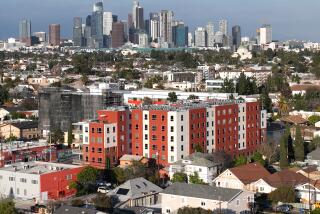Op-Ed: Downtown has a high apartment vacancy rate? The rest of L.A. should be so lucky
- Share via
For a city suffering from a housing crisis, the subject of real estate development has somewhat oddly become a wedge issue in Los Angeles. Despite the constant refrain from economists that an increase in supply is key to solving the region’s woes, anti-growth advocates have countered that the bulk of new projects charge rents that are unaffordable to the average Angeleno, and therefore can’t help end our problems.
Nowhere has this debate played out more contentiously than downtown Los Angeles. In 2016, backers of Measure S, the failed ballot initiative that sought to curtail high-density development within Los Angeles city limits, depicted downtown as a poster child for “overdevelopment,” with a growing collection of high-rise apartment and condo towers that cater to the wealthy while offering nothing for the working class.
Bolstering the anti-development argument, the real estate data firm CoStar revealed in September 2017 that the apartment vacancy rate downtown had reached 12.4%, three times higher than the citywide average. This vacancy rate raised eyebrows, even among growth advocates who recognize the need for more housing.
How can market rate apartments drive down rents when they’re sitting empty? Could economists possibly be wrong about something so fundamental as supply and demand?
The answer: of course not.
Downtown remains a relatively small pocket in the greater metropolitan region. Per CoStar, more than 1,600 apartments became available downtown in the first half of 2017, and approximately 7,000 additional units are scheduled for completion through late 2020. Nevertheless, the Downtown Center Business Improvement District estimates that the neighborhood’s population is just 67,000. As a result, the opening of a single 500-unit rental development is, by itself, capable of spiking the vacancy rate.
Twelve percent means less than it seems.
And that number has already come down. Last month, CoStar released new data showing that downtown’s vacancy rate dipped to 10.3%. It dropped even further last week, to 8.1%. Rents, meanwhile, remained flat for the year, despite an average 3.3% increase for Los Angeles County as a whole.
Another data point: Buildings that have been open for one year or more — and have thus had time to lease their units — have a vacancy rate of just 4.7%, roughly the same as the citywide average.
Downtown’s growth has created competition among landlords for residents. Prices have leveled accordingly, and many property owners have resorted to incentives such as free parking or discounted rent in order to lure tenants.
In real estate circles, a general rule-of-thumb is that a healthy vacancy rate for commercial office space is approximately 10%. In this scenario, prospective tenants have numerous options to choose from, but occupancy rates are still high enough that landlords can capitalize on their properties. We need to achieve this type of equilibrium for the apartment market in Los Angeles, and we can’t do it without increasing housing supply. That is, without allowing developers to build enough to satisfy demand.
Unfortunately, instead of ending restrictive zoning laws that curtail construction, government officials typically call for new funding streams for affordable housing, and in some instances, an expansion or revival of policies such as rent control. Though well-intentioned, most of these proposals are either stop-gap measures, or simply lack the scale to truly address our supply shortfall.
Downtown’s growth has created competition among landlords for residents. Prices have leveled accordingly.
Consider that Measure HHH, approved by Los Angeles voters in 2016, calls for spending $1.2 billion to create 10,000 units of permanent supportive housing over 10 years. Yet there are already more than 40,000 unsheltered homeless people living in Los Angeles County. The numbers don’t match up.
The reticence of lawmakers to tackle zoning is understandable; development is unpopular at both ends of the income spectrum. Homeowners, who tend to be older and wealthier, see dense multifamily construction as a threat to their “quality of life.” Renters, generally younger and less wealthy, see it as a harbinger of gentrification and displacement.
Legislators must ensure that development goes where it’s needed — near job centers and major transit corridors. That means ambitious building not only downtown, but on the Westside, the county’s largest employment center and the soon-to-be beneficiary of two multi-billion dollar rail lines.
Downtown isn’t a case study in what’s wrong with development in Los Angeles. It’s the best model we have for what’s right.
Steven Sharp is the co-founder and editor of Urbanize.LA, where he covers real estate development, architecture and urban planning. Follow him on Twitter @UrbanizeLA.
Follow the Opinion section on Twitter @latimesopinion or Facebook
More to Read
A cure for the common opinion
Get thought-provoking perspectives with our weekly newsletter.
You may occasionally receive promotional content from the Los Angeles Times.









